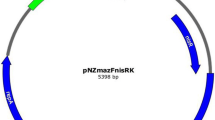Abstract
Lactococcus lactis subsp.lactis 484 produced a proteinaceous antibacterial substance designated as ‘lactococcin’ capable of inhibiting members of theLactococcus group,Bacillus cereus, Staphylococcus aureus, andSalmonella typhi. Growth of this culture in the presence of 2–30 μg/ml of ethidium bromide or acriflavin or novobiocin, and at elevated temperature (39° and 41°C), could not produce any lactococcin-negative (Lap−) variants. However, protoplast-induced curing with lysozyme was successful in developing Lap− derivatives. Two types of cured derivatives, namely Lac− Lap+ and Lac− Lap−, were obtained. Lap− variants were also lacking sucrose-fermenting ability (Suc+) and lactococcin resistance (Lapr). The lactose-negative (Lac−) variants and Lap+ were clearly lacking the largest (65 Md) plasmid. However, Lap− Suc− Laps variants lost a 2 Md plasmid.L. lactis subsp.lactis 484 transferred lactose-fermenting ability as well as Lap+ Suc+ Lapr phenotypes simultaneously toL. lactis subsp.lactis LM 2306 and LM 0230 by surface mating at a frequency of 10−4 and 10−1 per donor respectively. However, cured Lac− Lap− transconjugants could not transfer Lac+ Lap+ Suc+ Lapr phenotypes to any of these recipient strains. Our results indicate that Lac+ and Lap+ Suc+ Lapr phenotypes are associated with 65 Md and 2 Md plasmids respectively. Conjugal transfer of 2 Md plasmid is possible only in the presence of a conjugative 65 Md plasmid.
Similar content being viewed by others
Literature Cited
Anderson DG, McKay LL (1983) Simple and rapid method for isolating large plasmid DNA from lactic streptococci. Appl Environ Microbiol 46:549–552
Davey GP (1984) Plasmid associated with diplococcin production inSreptococcus cremoris. Appl Environ Microbiol 48:895–896
Davey GP, Pearce LE (1982) Production of diplococcin byStreptococcus cremoris and its transfer to non-producing N streptococci. In: Schlessinger D (ed) Microbiology. Washington, DC: American Society for Microbiology, pp 221–224
Davey GP, Richardson BC (1981) Purification and some properties of diplococcin fromStreptococcus cremoris 346. Appl Environ Microbiol 41:84–89
Davey GP, Appelby RD, Pearce LE (1986) Isolation of plasmid-freeStreptococcus cremoris strains by protoplast induced curing. NJZ Dairy Sci Technol 21:73–75
Elliker PR, Anderson A, Hannessen GH (1956) An agar culture medium for lactic acid streptococci and lactobacilli. J Dairy Sci 39:1611–1612
Fernandez EE, Torres VR, Castillo AA (1984) Inhibitory effect of strains ofStreptococcus, Lactobacillus andLeuconostoc spp. from fresh cheese on various enteropathogenic bacteria. Rev Latinoam Microbiol 26:47–51
Fuchs R, Zajdel J, Dobrzanski WT (1975) Possible plasmid nature of the determinant for production of the antibiotic nisin in some strains ofStreptococcus lactis. J Gen Microbiol 88:189–192
Fujita Y, Okamoto T, Irie R (1983) Protoplast formation and regeneration in lactic streptococci. Agric Biol Chem 47:2103–2105
Gasson MJ (1980) Production, regeneration and fusion of protoplasts in lactic streptococci. FEMS Microbiol Lett 9:99–102
Gasson MJ (1983) Plasmid complements ofStreptococcus lactis NCDO 712 and other lactic streptococci after protoplast induced curing. J Bacteriol 154:1–9
Gasson MJ (1984) Transfer of sucrose fermenting ability, nisin resistance and nisin production intoStreptococcus lactis 712. FEMS Microbiol Lett 21:7–10
Geis A, Singh J, Teuber M (1983) Potential of lactic streptococci to produce bacteriocin. Appl Environ Microbiol 45:205–211
Gonzales CF, Kunka BS (1985) Transfer of sucrose fermenting ability and nisin production phenotype among lactic streptococci. Appl Environ Microbiol 49:627–633
Gupta RK, Batish VK (1990) Screening lactic streptococci for antibacterial activity, plasmid profiles and biochemical performance. Microbiol Alim Nutr 8:45–52.
Gupta RK, Prasad DN (1989) Antibiotic activity of nisin in food preservation—a review. Microbiol Alim Nutr 7:199–208
Hurst A (1981) Nisin. Adv Appl Microbiol 27:85–123
Kekessy DA, Piguet JD (1970) New method for detecting bacteriocin production. Appl Microbiol 20:282–283
Klaenhammer TR (1988) Bacteriocins of lactic acid bacteria. Biochimie 70:337–349
Klaenhammer TR, McKay LL, Baldwin KA (1978) Improved lysis of group N streptococci for isolation and rapid characterization of plasmid DNA. Appl Environ Microbiol 35:592–600
Kozak W, Rajchart TM, Dobrzanski WT (1974) The effect of proflavin, ethidium bromide and an elevated temperature on the appearance of nisin negative colonies. J Gen Microbiol 83:295–302
Kozak W, Bardowski J, Dobrzanski WT (1978) Lactostrepsins—acid bacteriocins produced by lactic streptococci. J Dairy Res 45:247–257
Lin CW, Shin CH, Su HP (1986) Studies on the natural antimicrobial agents from lactic acid bacteria. 1. Primary screening of lactic cultures for antibacterial activity. J Chin Agric Chem Soc 24:384–391
Macrina FL, Kopecko DS, Jones KR, Ayers DJ, McCowen SM (1978) A multiple plasmid-containingEscherichia coli strain: convenient source of size reference plasmid molecules. Plasmid 1:417–420
McKay LL, Cords BR, Baldwin KA (1973) Transduction of lactose metabolism inStreptococcus lactis C2. J Bacteriol 115:810–815
McKay LL, Baldwin KA, Walsh PM (1980) Conjugal transfer of genetic information in group N streptococci. Appl Environ Microbiol 40:84–91
Neve H, Geis A, Teuber M (1984) Conjugal transfer and characterization of bacteriocin plasmid in group N (lactic acid) streptococci. J Bacteriol 153:833–838
Scherwitz KM, Baldwin KA, McKay LL (1983) Plasmid linkage of a bacteriocin like substance inStreptococcus lactis subsp.diacetylactis WM4 transferability toStreptococcus lactis. Appl Environ Microbiol 45:1506–1512
Steele JL, McKay LL (1986) Partial characterization of the genetic basis of sucrose metabolism and nisin production inStreptococcus lactis. Appl Environ Microbiol 51:57–64
Terzaghi BE, Sandine WE (1975) Improved medium for lactic streptococci and their bacteriophages. Appl Environ Microbiol 29:807–813
Tsai H, Sandine WE (1987) Conjugal transfer of nisin plasmid genes fromStreptococcus lactis 7962 toLeuconostoc dextranicum 181. Appl Environ Microbiol 53:352–357
Zajdel J, Dobrzanski WT (1983) Isolation and preliminary characterization ofStreptococcus cremoris strain 202 bacteriocin. Acta Microbiol Pol 32:119–129
Author information
Authors and Affiliations
Rights and permissions
About this article
Cite this article
Gupta, R.K., Batish, V.K. Genetic evidence for plasmid-encoded lactococcin production inLactococcus lactis subsp.lactis 484. Current Microbiology 24, 231–238 (1992). https://doi.org/10.1007/BF01579286
Issue Date:
DOI: https://doi.org/10.1007/BF01579286




